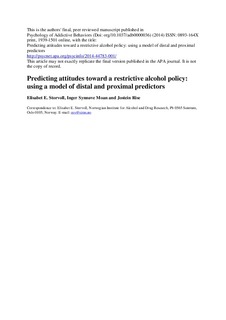| dc.description.abstract | Previous research on attitudes toward a restrictive alcohol policy has mainly focused on variables such as demographics and own drinking as possible predictors. The present article adds to the existing literature by examining the impact of a set of beliefs and personal experiences with the harm caused by other peoples’ drinking. We suggest and test an analytic model in which the predictors are ranked according to their conceptual proximity to attitudes. The data stem from a Web survey in the Norwegian adult population (N 1,951), mapping the respondents’ attitudes toward pricing policy and availability restrictions, belief in the harm-limiting effect of such measures, belief in the harm caused by drinking, and personal experiences with harm from others’ drinking. In line with the suggested model, belief in th effectiveness of restrictive measures and belief in the harm caused by drinking appeared as the strongest predictors. Attitudes were less strongly related to own drinking, and particularly to demographics. Altogether, 41% of the variance in attitudes was explained. Negative experience with other peoples’ drinking was a statistically significant predictor only among young respondents. The strong relationships between proximal predictors, such as belief in the harm caused by drinking and belief in the harmlimiting effect of restrictive measures and attitudes, indicate that support for a restrictive policy may be increased by focusing on awareness of such issues rather than on more distal predictors. However, further research is needed to acquire more knowledge about the mechanisms behind these associations. | |
